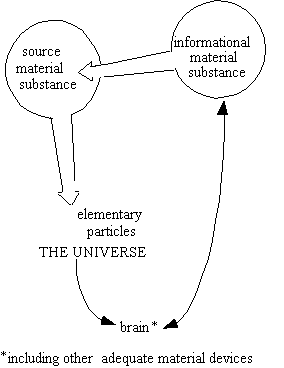It is certain that there is a passage and
an "interface" between the physio-neurological activity
of the brain and its mental states through its integrative activity.
Physiologically, the complex brain activity is able to create
an advanced integration of the physiological processes, but the
way in which the jump from this preparatory integrative activity
to the integrated state is done is not yet known.
J. Konorski100
considers that the neurons in the brain constitute "gnosic"
units. For him these gnosic units are entirely stimulated by several
specific elements of a complex stimulus. These elements make the
stimulus be recognized in its entire self. This happens, for example,
when we recognize a face according to same characteristic features.The gnosic units
form gnosic fields101.

Fig. 25
The gnosic units and the gnosic fields represent
an integrative concept expressing the need for constructing
a model of brain's integrative activity. However, such a model
is still missing. We believe that at the moment three types of
models are possible:
- The integration is done through a mentalfield, either a physical or
(in extreme) a mere mathematicalconcept explaining the actual
functioning of our brain.
- The mental field is an objective reality,a new way of material manifestation
in our known, 4-dimensional,universe. This field is generated by the complexity of
brain functioningand it has properties that science has still to discover. This
model, in first approximation, does not negate the possibility
of orthoexistence, but one connected to our universe only viainert substances.
- The mental field is an objective reality
made up of a substance that can be found as such only in orthoexistence.
Hence the mental field itself is placed in orthoexistence.
Among these three kinds of models we incline
philosophically towards the third (C). This model offers an exit
from the existence paradox, offers a rationality of existence,
and at the same time an opening towards creation, since the latter
can only result from a turmoil of the matter, from reaching a
superior informational state manifested by intelligence and high
psychological properties. In view of this model the human spirit
appears as integrative mental activity,(on the psychological
plane) and beingness. These ideas are sketched in Fig. 26.

Fig. 26
Beingness has a specific role, it is neither thought nor spirit.
Beingness is that giving man properties above machine and automaton.
But the human brain continues to remain a material device with
its principal functions being thinking, affectionate life and
will, under the influence of social life and of beingness. The
affectionate life is a particular type of thinking of the human
brain, having a neuronic machine-background similar to abstract
thinking, but specific. Kant eliminated the affectionate aspect
from reasoning, although it has an important role in man's spiritual
life which, at its higher levels, implies beingness, awareness;
and it is one of the source elements for social values
and ideology. Will is also a form of thinking and, as we
have seen, it can be understood in various shades. Psychologically
and neurologically, the will is perhaps the least
understood102.
V. The Class of "PSY" Phenomena
There is a lot of literature regardingexperiments and
spontaneous cases of "psy"
processes. The psy processes, (also called para-psychological
or para-normal) are classed into two types:
- extra sensory perception (ESP) containing
the mental perception of some physical states (MPPS or clairvoyance),
telepathy, and precognition;
- psychokinesis, representing the
direct influence of mind upon matter.
The existence of certain psy processes cannot be doubted experimentally, especially
regarding telepathy105,
sometimes referred to as
bio-radio106.
The fact that this is not an electromagnetic field interaction
(i.e. no radio-mental activity) has been clarified through numerous
experiments that showed that the telepathic effect does not decrease
in the ratio 1/d2 (i.e. inversely proportional to the squared distance)
like inradio transmissions; on the contrary, when the subjective impression
is eliminated, the distance seems to bear no effect at all. Similarly,
electromagnetic screening has no effect
either107.
However, the information contents transmitted via telepathy is
not very rich. Having a spontaneous manifestation, usually under
strong dramatic emotions108,
this phenomenon was experimentally successful only in transmitting
simple geometric figures, or some images.
Charles A. Tart, author of several models
for describing psy processes believes that although there is experimental
evidence regarding these events, scientists do not accept them
yet since science has not yet got a theory for explaining them.
These phenomena are "meaningless in connection with the currenttheories about
the world"109,
since "mind seems to transcend the usual laws of space and
time"110.
The hypothesis has also been raised of whether these phenomena
were not an "arbitrary reprogramming of the biologic
computer"111,
but Charles A. Tart maintains that there is experimental evidence
in their favour. His
model112
for the ESP phenomena is that of Fig. 27, the brain receiving information
through a transmission and decoding channel that is different
from the usual, sensorial way.
Biology and Psychology in Relation with Awareness
67







